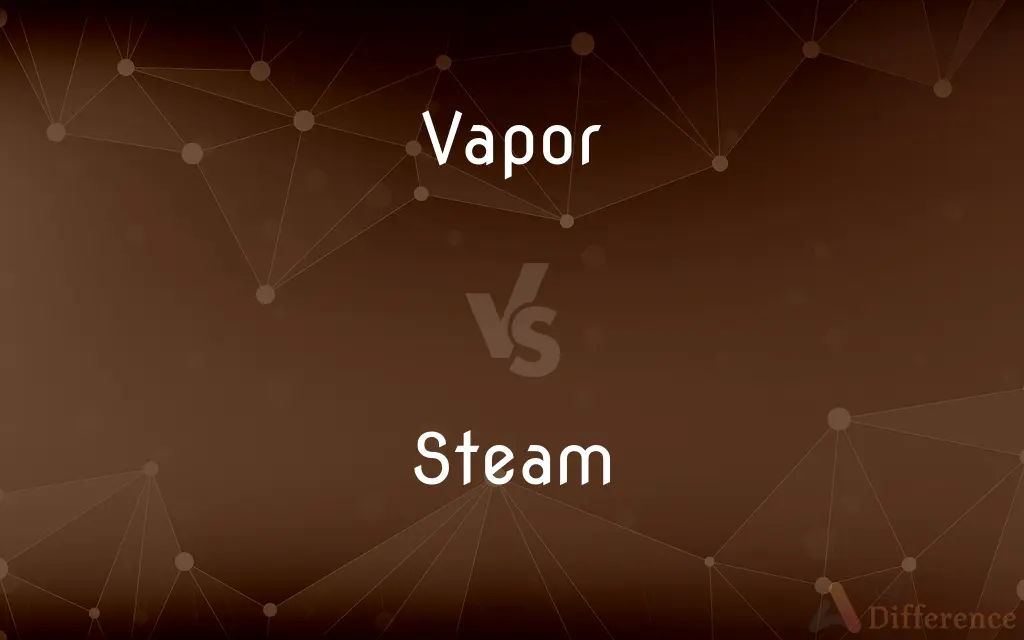Vapor vs. Steam — What's the Difference?
Edited by Tayyaba Rehman — By Urooj Arif — Updated on March 15, 2024
Vapor is the gaseous form of a substance below its critical temperature, applicable to various substances, while steam specifically refers to water vapor that's above the boiling point of water.

Difference Between Vapor and Steam
Table of Contents
ADVERTISEMENT
Key Differences
Vapor encompasses the gaseous state of any substance that exists in a liquid or solid form at room temperature and pressure, before it reaches its critical point. For example, the vapor from volatile liquids like alcohol or gasoline is commonly observed at room temperature. On the other hand, steam specifically refers to the gas phase of water, particularly when it's generated from boiling water, which occurs at temperatures above 100°C (212°F) at standard atmospheric pressure.
The term "vapor" is often used in contexts that involve phase changes at temperatures and pressures where the substance is typically not a gas. This includes the water vapor present in the air, which is invisible and exists at temperatures below the boiling point of water. Whereas steam, especially in everyday language, usually implies visible water vapor that condenses into tiny droplets when cooled, forming a white, misty appearance often associated with boiling kettles, steam engines, or steam baths.
In scientific and technical contexts, "vapor" is used to describe a substance's gaseous state when it's in equilibrium with its liquid or solid form. This equilibrium state is crucial in processes like distillation and evaporation. Conversely, "steam" is critical in industrial and mechanical applications, where its high energy content and capacity to do work, such as in steam turbines or heating systems, are utilized.
The energy content of vapor varies depending on the substance and its conditions. For instance, the vapor of volatile liquids at room temperature contains relatively low energy compared to steam. Steam, due to its formation at high temperatures, carries significant thermal energy, which is evident in its use for sterilization, cooking, and power generation.
Lastly, the safety considerations for handling vapor and steam differ. Vapors from substances like gasoline can be highly flammable and pose risks of fire or explosion at relatively low temperatures. Steam, while not flammable, can cause severe burns due to its high heat content and is therefore handled with caution in culinary and industrial settings.
ADVERTISEMENT
Comparison Chart
Definition
Gaseous state of a substance below its critical temperature.
Gaseous state of water above its boiling point.
Visibility
Often invisible, e.g., water vapor in the air.
Can be visible when cooled, forming a misty appearance.
Temperature Range
Can exist at a wide range of temperatures.
Typically above 100°C (212°F) at standard atmospheric pressure.
Applications
Used in perfumes, cooling, and chemical processes.
Utilized in power generation, cooking, and heating.
Energy Content
Depends on the substance; generally lower than steam.
High thermal energy, capable of performing work.
Compare with Definitions
Vapor
The gaseous form of a substance that is liquid or solid at room temperature.
The vapor from the perfume bottle spread a pleasant scent.
Steam
Water in its gas phase, particularly when produced by boiling.
Steam rose from the boiling pot of water.
Vapor
Invisible gases formed from substances like water at lower temperatures.
Water vapor contributes to the greenhouse effect.
Steam
Used as a power source in engines and turbines.
The old locomotive was powered by steam.
Vapor
Can be hazardous depending on the substance.
Gasoline vapor is highly flammable and dangerous.
Steam
Visible when it cools and condenses in the air.
The bathroom filled with steam during the hot shower.
Vapor
Essential in the natural water cycle.
Water vapor in the air condenses to form clouds.
Steam
Carries significant heat energy.
Steam is used to sterilize medical equipment.
Vapor
Used in various industrial and chemical processes.
The factory uses chemical vapor for the deposition process.
Steam
Can cause burns if not handled carefully.
She accidentally burned her hand with the steam from the kettle.
Vapor
In physics, a vapor (American English) or vapour (British English and Canadian English; see spelling differences) is a substance in the gas phase at a temperature lower than its critical temperature, which means that the vapor can be condensed to a liquid by increasing the pressure on it without reducing the temperature. A vapor is different from an aerosol.
Steam
Steam is water in the gas phase. This may occur due to evaporation or due to boiling, where heat is applied until water reaches the enthalpy of vaporization.
Vapor
The gaseous state of a substance that is liquid or solid at room temperature.
Steam
The vapour into which water is converted when heated, forming a white mist of minute water droplets in the air
A cloud of steam
She wiped the steam off the mirror
Steam was rising from the mugs of coffee
Vapor
A faintly visible suspension of fine particles of matter in the air, as mist, fumes, or smoke.
Steam
Give off or produce steam
A mug of coffee was steaming at her elbow
Vapor
A mixture of fine droplets of a substance and air, as the fuel mixture of an internal-combustion engine.
Steam
Cook (food) by heating it in steam from boiling water
Steam the vegetables until just tender
Vapor
Something insubstantial, worthless, or fleeting.
Steam
(of a ship or train) travel somewhere under steam power
The 11.54 steamed into the station
Vapor
A fantastic or foolish idea.
Steam
Be or become extremely agitated or angry
You got all steamed up over nothing!
After steaming behind the closed door in his office, he came out and screamed at her
Vapor
Exhalations within a bodily organ, especially the stomach, supposed to affect the mental or physical condition. Used with the.
Steam
Hot water vapor produced especially by boiling liquid water.
Vapor
A nervous disorder such as depression or hysteria. Used with the.
Steam
Hot, pressurized water vapor used for heating, cooking, or to provide mechanical power.
Vapor
To fill or cover with vapor
Perfume vapored the room.
Steam
Power generated by the expansion of boiling water as it turns to vapor
An engine at full steam.
Vapor
To vaporize
“You wished you'd seen one of the monster shots that vapored an atoll way back when” (Don DeLillo).
Steam
Steam heating.
Vapor
To give off vapor.
Steam
Condensed water vapor in the form of a mist or cloud
The steam from the teakettle.
The steam of the oxen's breath in the cold air.
Vapor
To evaporate
The fog vapored away.
Steam
Power; energy
The fundraising effort ran out of steam.
Vapor
To engage in idle, boastful talk
Vapored on about his accomplishments.
Steam
To produce or emit steam
The kettle is steaming. Let's make tea.
Vapor
Cloudy diffused matter such as mist, steam or fumes suspended in the air.
Steam
To become or rise up as steam
The rain steamed off the hot pavement.
Vapor
The gaseous state of a substance that is normally a solid or liquid.
Steam
To become misted or covered with steam
The bathroom mirror steamed over.
Vapor
Something insubstantial, fleeting, or transitory; unreal fancy; vain imagination; idle talk; boasting.
Steam
To move by means of steam power.
Vapor
(dated) Any medicinal agent designed for administration in the form of inhaled vapour.
Steam
(Informal) To become very angry; fume.
Vapor
Hypochondria; melancholy; the blues; hysteria, or other nervous disorder.
Steam
To expose to steam, as in cooking.
Vapor
(obsolete) Wind; flatulence.
Steam
To cover or mist with steam
The windows are steamed up.
Vapor
(intransitive) To become vapor; to be emitted or circulated as vapor.
Steam
(Informal) To make angry
His laziness really steams me.
Vapor
(transitive) To turn into vapor.
To vapor away a heated fluid
Steam
The vapor formed when water changes from the liquid phase to the gas phase.
Vapor
To emit vapor or fumes.
Steam
The suspended condensate (cloud) formed by water vapour when it encounters colder air
Vapor
(intransitive) To use insubstantial language; to boast or bluster.
Steam
, fog
Vapor
(transitive) To give (someone) the vapors; to depress, to bore.
Steam
Exhaled breath into cold air below the dew point of the exhalation
Vapor
Any substance in the gaseous, or aëriform, state, the condition of which is ordinarily that of a liquid or solid.
Vapor is any substance in the gaseous condition at the maximum of density consistent with that condition. This is the strict and proper meaning of the word vapor.
Steam
Pressurized water vapour used for heating, cooking, or to provide mechanical energy.
Vapor
In a loose and popular sense, any visible diffused substance floating in the atmosphere and impairing its transparency, as smoke, fog, etc.
The vapour which that fro the earth glood [glided].
Fire and hail; snow and vapors; stormy wind fulfilling his word.
Steam
The act of cooking by steaming.
Give the carrots a ten-minute steam.
Vapor
Wind; flatulence.
Steam
(figuratively) Internal energy for motive power.
After three weeks in bed he was finally able to sit up under his own steam.
Vapor
Something unsubstantial, fleeting, or transitory; unreal fancy; vain imagination; idle talk; boasting.
For what is your life? It is even a vapor, that appeareth for a little time, and then vanisheth away.
Steam
(figuratively) Pent-up anger.
Dad had to go outside to blow off some steam.
Vapor
An old name for hypochondria, or melancholy; the blues.
Steam
A steam-powered vehicle.
Vapor
A medicinal agent designed for administration in the form of inhaled vapor.
Steam
Travel by means of a steam-powered vehicle.
Vapor
To pass off in fumes, or as a moist, floating substance, whether visible or invisible, to steam; to be exhaled; to evaporate.
Steam
(obsolete) Any exhalation.
Vapor
To emit vapor or fumes.
Running waters vapor not so much as standing waters.
Steam
(fencing) Fencing without the use of any electric equipment.
Vapor
To talk idly; to boast or vaunt; to brag.
Poets used to vapor much after this manner.
We vapor and say, By this time Matthews has beaten them.
Steam
To cook with steam.
The best way to cook artichokes is to steam them.
Vapor
To send off in vapor, or as if in vapor; as, to vapor away a heated fluid.
He'd laugh to see one throw his heart away,Another, sighing, vapor forth his soul.
Steam
(transitive) To expose to the action of steam; to apply steam to for softening, dressing, or preparing.
To steam wood or cloth
Vapor
A visible suspension in the air of particles of some substance
Steam
(intransitive) To produce or vent steam.
Vapor
The process of becoming a vapor
Steam
(intransitive) To rise in vapour; to issue, or pass off, as vapour.
Our breath steamed in the cold winter air.
Steam
To become angry; to fume; to be incensed.
Steam
To make angry.
It really steams me to see her treat him like that.
Steam
(intransitive) To be covered with condensed water vapor.
With all the heavy breathing going on the windows were quickly steamed in the car.
Steam
(intransitive) To travel by means of steam power.
We steamed around the Mediterranean.
The ship steamed out of the harbour.
Steam
To move with great or excessive purposefulness.
If he heard of anyone picking the fruit he would steam off and lecture them.
Steam
(obsolete) To exhale.
Steam
Old-fashioned; from before the digital age.
Steam
The elastic, aëriform fluid into which water is converted when heated to the boiling point; water in the state of vapor.
Steam
The mist formed by condensed vapor; visible vapor; - so called in popular usage.
Steam
Any exhalation.
Steam
To rise in vapor; to issue, or pass off, as vapor.
The dissolved amber . . . steamed away into the air.
Steam
To move or travel by the agency of steam.
The vessel steamed out of port.
Steam
To generate steam; as, the boiler steams well.
Steam
To exhale.
Steam
To expose to the action of steam; to apply steam to for softening, dressing, or preparing; as, to steam wood; to steamcloth; to steam food, etc.
Steam
Water at boiling temperature diffused in the atmosphere
Steam
Travel by means of steam power;
The ship steamed off into the Pacific
Steam
Emit steam;
The rain forest was literally steaming
Steam
Rise as vapor
Steam
Get very angry;
Her indifference to his amorous advances really steamed the young man
Steam
Clean by means of steaming;
Steam-clean the upholstered sofa
Steam
Cook something by letting steam pass over it;
Just steam the vegetables
Common Curiosities
What is vapor?
Vapor is the gaseous phase of a substance that can exist in a liquid or solid state under standard conditions, encompassing a wide range of materials.
What is steam?
Steam is the gaseous state of water, particularly visible as fine droplets, produced when water boils and cools slightly in the air.
Can all liquids form vapor?
Yes, all liquids can form vapor at various temperatures, often below their boiling points, through evaporation.
Can vapor be harmful?
Depending on the substance, vapor can be harmless or potentially harmful if it contains toxic chemicals or irritants.
How does pressure affect the formation of steam?
Increasing pressure raises the boiling point of water, requiring higher temperatures to form steam.
What is "dry steam" in geothermal energy?
Dry steam refers to steam with very little water content, used directly from geothermal reservoirs to drive turbines for electricity generation.
Why is vapor pressure important?
Vapor pressure indicates a liquid's evaporation rate and volatility at a given temperature, crucial in many scientific and industrial processes.
Why is steam often used in industrial processes?
Steam carries a significant amount of heat energy, making it efficient for heating, power generation, and mechanical work.
How does humidity relate to water vapor?
Humidity measures the amount of water vapor in the air, affecting weather, comfort levels, and various processes.
Can steam clean surfaces?
Yes, steam cleaning uses hot steam to remove dirt and sanitize surfaces, exploiting steam's high heat and moisture.
Is the vapor from an e-cigarette the same as steam?
While similar in appearance, the vapor from an e-cigarette typically contains a mixture of substances, whereas steam is specifically water vapor.
Is steam always hot?
Steam is initially very hot when formed but can cool rapidly when exposed to air, becoming visible as it condenses into water droplets.
Can vapor exist in a vacuum?
Yes, vapor can exist in a vacuum, but its properties and behavior will differ due to the lack of atmospheric pressure.
Why do we see vapor trails from aircraft?
Vapor trails, or contrails, form from aircraft exhaust as water vapor condenses and freezes into ice crystals in the cold upper atmosphere.
What is sublimation in the context of vapor?
Sublimation is the direct transition of a substance from solid to gas without passing through the liquid phase, producing vapor.
Share Your Discovery

Previous Comparison
Accord vs. Accordance
Next Comparison
Map vs. AtlasAuthor Spotlight
Written by
Urooj ArifUrooj is a skilled content writer at Ask Difference, known for her exceptional ability to simplify complex topics into engaging and informative content. With a passion for research and a flair for clear, concise writing, she consistently delivers articles that resonate with our diverse audience.
Edited by
Tayyaba RehmanTayyaba Rehman is a distinguished writer, currently serving as a primary contributor to askdifference.com. As a researcher in semantics and etymology, Tayyaba's passion for the complexity of languages and their distinctions has found a perfect home on the platform. Tayyaba delves into the intricacies of language, distinguishing between commonly confused words and phrases, thereby providing clarity for readers worldwide.















































